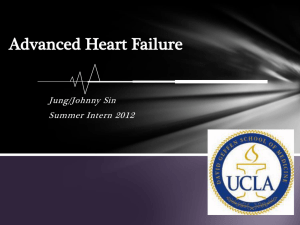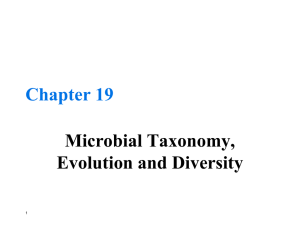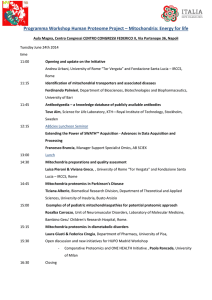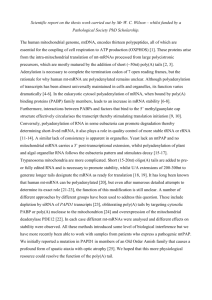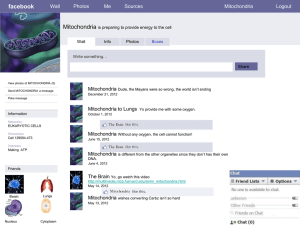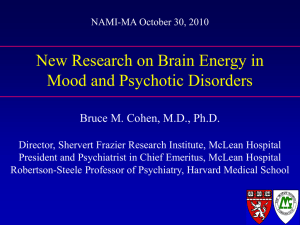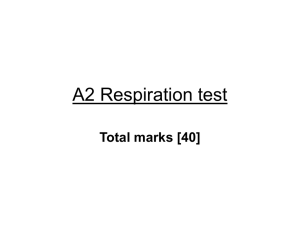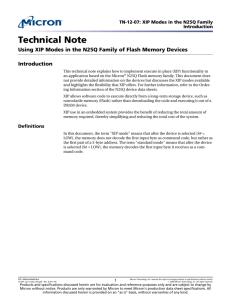Mitochondria
advertisement
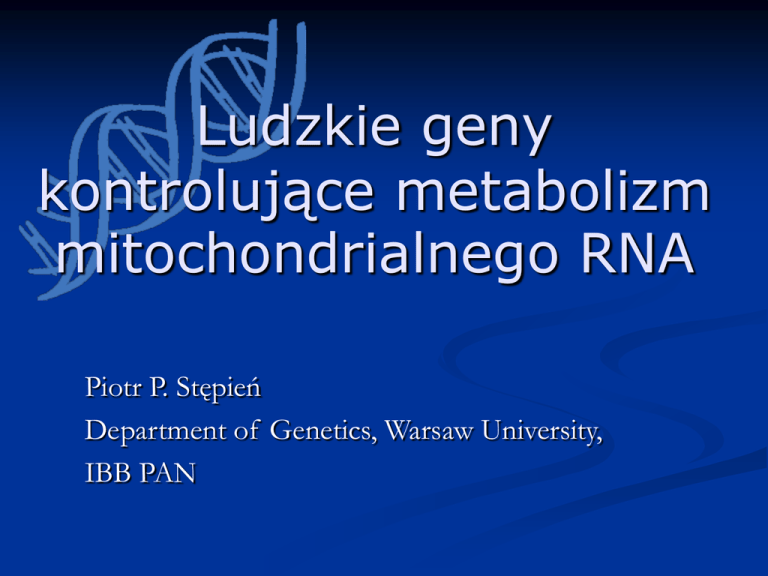
Ludzkie geny kontrolujące metabolizm mitochondrialnego RNA Piotr P. Stępień Department of Genetics, Warsaw University, IBB PAN Mitochondria Molecular probes Viable bovine pulmonary artery endothelial cells Molecular probes Potential-dependent staining of mitochondria in CCL64 fibroblasts Funkcje Cykl Krebsa Synteza ATP Bufor Ca2+ Apoptoza Utlenianie kwasów tłuszczowych, cykl mocznikowy Około 1000 białek, z czego 13 kodowane w mtDNA Gdy mitochondria są niesprawne Różne tkanki mają różne wymagania energetyczne mięśnie szkieletowe mięsień sercowy neurony komórki β trzustki Choroby mitochondrialne Starzenie się Dlaczego się starzejemy? 4 główne teorie : Program ewolucyjny : Geny Wolne rodniki Glikacja białek Defekty w mitochondriach Mitochondria a starzenie Wolnorodnikowa teoria starzenia: wolne rodniki, powstające głównie w mitochondriach mogą prowadzić do powstawania mutacji w mtDNA, co z kolei może upośledzać funkcję mitochondriów i przyczyniać się do wzrostu produkcji ROS (sprzężenie zwrotne) długowieczność może zależeć od sprawności łańcucha oddechowego i enzymów usuwających wolne rodniki Modele doświadczalne w badaniach nad starzeniem: Progerie u ludzi Myszy transgeniczne Mutanty Drosophila, C.elegans, drożdży Progeria Hutchinsona-Gilforda: lamina A Zespół Wernera: mutacja w helikazie WRN Eksperymentalnie wydłużone życie Zwierzęta na diecie :Calorie restriction Myszy: Obniżone wytwarzanie wolnych rodników mniej uszkodzeń oksydacyjnych – w wyniku słabszego działania kompleksu I Indukcja sirtuiny Eksperyment łączący funkcje mitochondrialne z apoptozą i starzeniem (Kujoth et al., Science 2005): Transgeniczne myszy z uszkodzonym genem mitochondrialnej polimerazy DNA (brak akt. korektorskiej) Średnio jedna mutacja na mt genom Przedwczesne starzenie w wyniku apoptozy, ale bez zmian ROS Starzejące się myszy Dlaczego badamy metabolizm RNA w mitochondriach? Niewiele na ten temat wiadomo Degradacja mtRNA gra podstawowa rolę w regulacji ekspresji genów w mitochondriach Nasze najnowsze badania sugerują, że białka kontrolujące przemiany mRNA w mitochondriach regulują cykl komórkowy i apoptozę M. Gadaleta ( Bari University) What happens after 50 in human cells? Strong 13x induction of mt transcription factors Balance between synthesis and degradation of mt RNA Our research: Yeast model Mammalian cells Functions of human mitochondrial proteins outside mitochondria Speculations and research plans Kompleksy degradujace RNA Prime object of our research Yeast mitochondrial degradosome Genes coding for yeast degradosome subunits : SUV3 • DExH-box RNA helicase, 84 kDa •Very ancient gene, orthologs found in purple bacteria, plants, Drosophila and Homo sapiens ( Stepien et al.., PNAS 1992) DSS1 • RNase, homologous to bacterial RNase II •Isolated as a multicopy suppressor of the SUV3 deletion •110 kDa ( Dmochowska et al., Curr.Genet., 1995; Dziembowski et al., Mol.Gen.Genet, 1998, JBC 2003) The working model: less is more wild-type RNA Reduced levels of mostly correctly processed transcripts suv3Δ Secondary degradation routes Degradation (Suv3p+ Dss1p) Reduced transcription (Rpo41psupor Mtf1psup) Secondary degradation routes RNA Degradation (Suv3p+ Dss1p) Transcription (Rpo41p+ Mtf1p) Secondary degradation routes Degradation (Suv3p+ Dss1p) Transcription (Rpo41p+ Mtf1p) RNA Normal levels of correctly processed transcripts Accumulation of mis-processed RNAs and high molecular weight precursors suv3Δ, su Reduced transcription rescues the balance lost due to disrupted degradation Experiments in progress: Crystalization of the complex We hope to resolve the structure Biochemical analysis is on the way Prime object of our research Wielki problem biologii molekularnej Z sekwencji genu nie potrafimy określić funkcji białka Konieczność badań biochemicznych Our approach: We identify human orthologues in silico We clone cDNA of a candidate, attach fluorescent tag, and check mito localization We silence the gene by siRNA and watch for phenotypes Our research on human genes: We identified, cloned cDNAs and analyzed 4 human nuclear genes: SUV3 helicase ( Dmochowska et al., Acta Biochim. Pol. 1999; Dmochowska et al., Cytogen. Cell Genet, 1999; Minczuk et al., NAR 2002, Minczuk et al.., BBA in press) polynucleotide phosphorylase (Piwowarski et al., J.Mol.Biol. 2003) poly(A) polymerase Tomecki et al.., NAR 2004) RNase unpublished) ( Part I : polyadenylation The role of human mtRNA polyadenylation is not known : evolutionary paradox: diverse roles of poly(A) tails The paradox In procaryotes polyA tails are signal for degradation In eukaryotic cytosol polA tails stabilize mRNA In plant mitochondria : polyA tails destabilize Yeast mitochondria do not polyadenylate at all Human mitochondria ????????? Human mitochondrial poly(A) polymerase We identified the nuclear gene Cloned the cDNA Demonstrated mito localization by GFP fusion siRNA PAP silencing siRNA of human mt polyA polymerase : ND3 mtRNA Two kinds of mito poly(A) tails: Poly(A) : 40 – 50 A residues Oligo(A) : 5 A residues Both poly(A) and oligo(A) mitochondrial mRNAs are stable Oligo(A) mRNA is translatable Nagroda PTBioch. im . J. Parnasa oraz Nagroda PTGen 2005: „Identification of a novel human nuclearencoded mitochondrial poly(A) polymerase” Rafał Tomecki, Aleksandra Dmochowska, Kamil Gewartowski, Andrzej Dziembowski, Piotr P. Stępień Nucleic Acid Research 32:6001, 2004 PART II: Our research on human SUV3 helicase: Human SUV3 gene is the orthologue of yeast SUV3 Genetics : a global science Craig Venter : EST Buy yourself a gene Overexpressed hSuv3myc is localized in mitochondria in HeLa cells hSuv3p is localized in the mitochondrial matrix in HeLa cells 1. crude mitochondrial fraction 2. cytosolic fraction 3. total cell extract 1. soluble submitochondrial fraction 2. membrane submitochondrial fraction 3. total extract of purified mitochondria 1. mitoplasts 2. post-mitoplast supernatant 3. total extract of purified mitochondria Heterologically expressed hSuv3p has DNA and RNA unwinding activity in vitro Comparison of efficacy of RNA and DNA unwinding reaction mediated by hSuv3p as function of decreasing enzyme concentrations. 4.7 pM substrate and the following enzyme concentrations were used: 2 & 8 0.66 fM; 3 & 9 66 fM; 4 & 10 6.6 pM; 5 & 11 0.66 nM 6 & 12 66 nM. The substrate and released strand were separated in a TBE polycrylamide gel and visualised by exposition of dried gel onto X-ray film for 24 h. TWO QUESTIONS: what is the SUV3 function in mitochondria, is there a human mito degradosome? what is the SUV3 function outside of mitochondria ? We employed yeast two-hybrid system to find human SUV3 interactors our results : XIP Hsp60 Human XIP protein (HBXIP) XIP is a 9,6 kDa protein interacting with HBx protein of hepatitis B virus (Melegari et al., 1998) HBx is responsible for HBV pathogenesis Similarly to Suv3p, XIP is highly conserved during evolution The expression profile of XIP in humans is almost identical as compared with hSUV3 Xip interacts with carboxy-terminal fragment of the hSuv3p protein Pull-down experiment XIP-TAPtag fusion was expressed in E.coli, attached to IgG-agarose hSUV3-myc fusions were expressed in vitro, labeled with S-35 methionine After incubation and elution, samples were analyzed on SDS_PAGE Pull-down of in vitro – translated hSuv3p protein by overexpressed XIP Do XIP and SUV3 interact in mitochondria? Subcellular localisation of XIP was not known Xip is localised in nucleus and cytoplasm of mammalian cells The site of XIP-SUV3 interaction is not in mitochondria Since SUV3 was assumed to be mitochondrial protein and XIP is not in mitochondria : how does it work ???????- Recent data on XIP Marusawa et al., EMBO J. 2003 XIP is a cofactor of survivin in apoptosis suppression US patent filed Survivin, 17 kDa: One of the most tumor-specific human genes Normally functions in chromosome segregation Survivin supresses apoptosis Inhibition of survivin induces caspasedependent death in tumor cell lines but not in normal cells Eli Lilly Company: bought siRNA protocoll for survivin suppression from Isis Co. for 1 Million USD Ist phase clinical studies on patients with cancer Is there a link ???? SUV3 XIP survivin Our working model: Complex SUV3-XIP can regulate apoptosis In the absence of SUV3 cancer cells undergo cell death Patent application: Warsaw University: „The use of modulation of hSUV3 expression for apoptosis induction in cancer” 2005 Published: Minczuk et al., BBA 2005 Minczuk et al.., FEBS J., 2005 Is human SUV3 always in the nucleus? Are mitochondria a reservoir of SUV3, which is released in certain physiological conditions? what is the intracellular SUV3 trafficking ? Is SUV3 really involved in caspase-9 apoptotic pathway? PART III : Our research on other human mitochondrial proteins involved in RNA turnover PNPase : polinucleotide phosphorylase Poly(A) polymerase Podwójna funkcja PNPazy: W mitochondriach reguluje stabilność mRNA Poza mitochondriami wpływa na cykl komórkowy Human polynucleotide phosphorylase (hPNPase) is associated with cellular senescence and terminal differentiation Leszczyniecka et al ( PNAS 2002, 99:16636-16641) have shown that : hPNPase is up-regulated: in senescent progeroid fibroblasts, fibroblasts entering terminal differentiation after interferon beta treatment overexpression of hPNPase resulted in growth inhibition of human melanoma cells, this suggests the possible use in gene therapy patent application for the hPNPase was filed human PNPase is localized in the cytoplasm ( THIS WAS THEIR SUMMARY We study human genes involved in mt RNA turnover: SUV3, Poly(A) polymerase, PNPase SUV3 and PNPase seem to play an additional role in regulating cell cycle events Standard approach: Biochemical parameters Interactors ( Flp-in system and TAP-TAG) Submitochondrial localisation Influence on RNA turnover RNA-protein complexes siRNA studies Protein models All four human proteins : SUV3 PNPase polyA polymerase are currently overexpressed in their native conformation, crystallized and analyzed by X-ray diffraction (
